When will Dinosaurs: The Final Day with David Attenborough be on TV?
Dinosaurs: The Final Day with David Attenborough will air on BBC One on Friday 15th April 2022, and will be available to stream on BBC iPlayer afterwards.
What is Dinosaurs: The Final Day with David Attenborough about?
The 90-minute film reveals what happened when an asteroid the size of Mount Everest hit the planet 66 million years ago, at the end of the Cretaceous Period.
The story is centred not on the impact site, the Chicxulub Crater in Mexico’s Yucatan Peninsula, but on a little-known spot in the Hell Creek formation of North Dakota. It’s there that palaeontologist Robert DePalma and his team made a remarkable discovery in a prehistoric graveyard DePalma’s named Tanis. What they found were astonishingly well-preserved fossilised creatures, buried in a mysterious crumbly layer of rock.
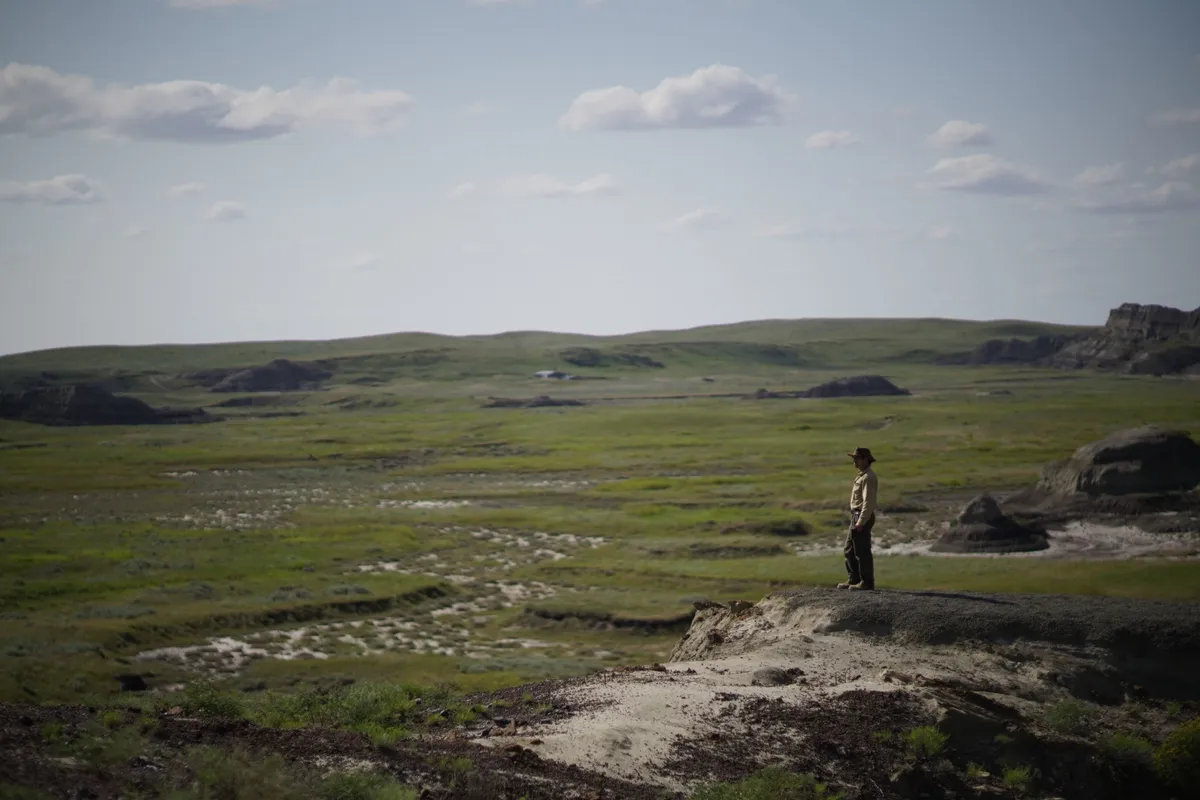
Among the fossils unearthed were fish, the tooth of a Tyrannosaurus rex, an almost complete turtle and Triceratops remains. But it’s the crumbly rock they were found in that’s truly astonishing.
The programme follows DePalma and his team as they discover the rock at Tanis is full of ejecta spherules – tiny beads of molten glass which, over millions of years, have turned into clay. These spherules were created by an asteroid impact that blasted molten and vaporised rock into space where it solidified and fell back to Earth as tiny spheres. Analysis of the spherules shows they came from the impact at Chicxulub – the impact believed to have condemned the dinosaurs to extinction.
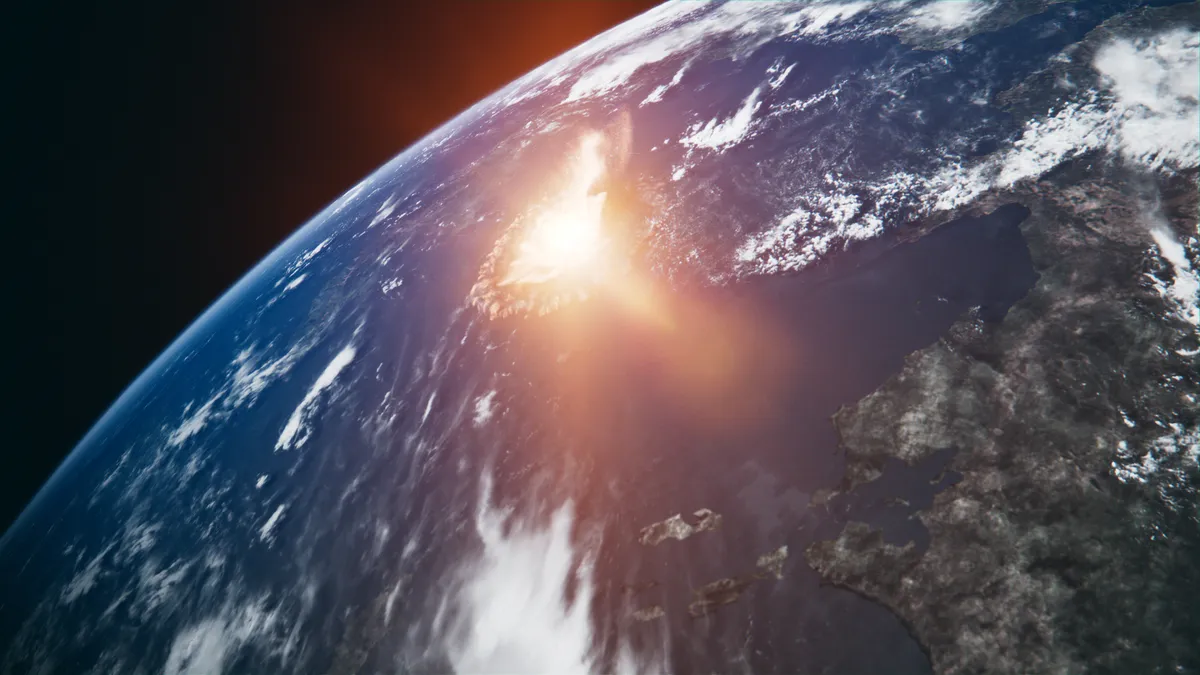
This discovery makes Tanis an incredible site for learning about the last day of the dinosaurs, providing a detailed record, preserved in rock, of the moments after the asteroid hit Earth. With exclusive access to the dig site, BBC cameras follow DePalma and his team as they hunt for evidence that can shed light on their demise.
Throughout the programme state-of-the-art special effects transport Attenborough back in time to the Late Cretaceous to witness the creatures who lived at Tanis, before re-creating, in extraordinary detail, the events of the last day of the dinosaurs.
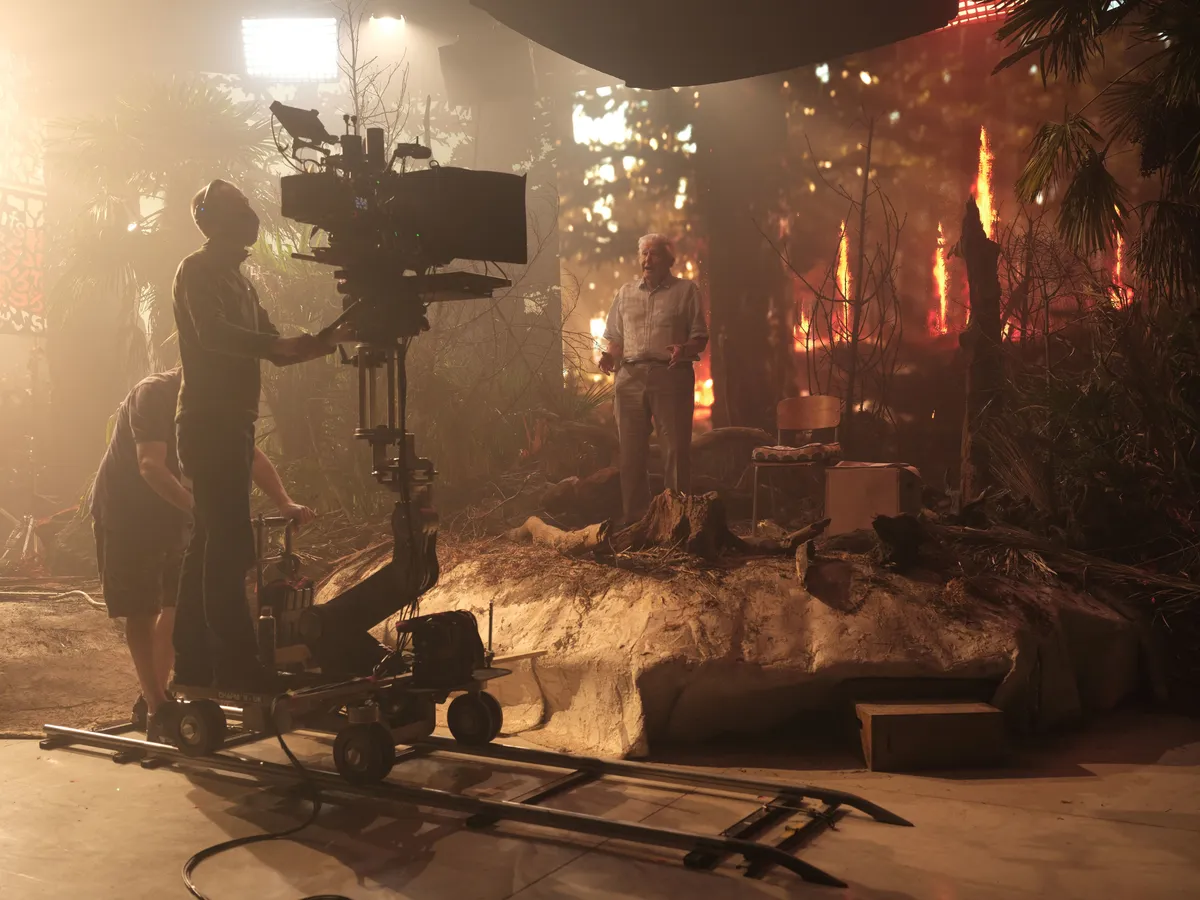
Who is David Attenborough?
Sir David Attenborough is one of the world's best-known TV presenters and narrators, famed for his work on natural history documentaries for the BBC and other broadcasters. His recent programmes include Dynasties II, Attenborough's Wonder of Song, Attenborough and the Mammoth Graveyard and The Green Planet.
Interview with Sir David Attenborough and Helen Thomas (Executive Producer)
Can you tell us what Dinosaurs: The Final Day, with David Attenborough is about?
Sir David: The film is about the last day the dinosaurs lived on Earth – and the minute by minute detail of that day. We tend to think that the end of a [geological] period extends over decades, if not centuries, and actually the end of a period may vary around the world in different areas.
But what's remarkable about this, is that it was one astonishingly huge event that was worldwide. An object the size of Mount Everest hit the Earth and that was the end of the Cretaceous - and that's an extraordinary thing to happen. And of course it's extraordinary too because it caused the end of the dinosaurs. And the life on this planet, had to restart.
Helen: Three quarters of all the species eventually disappeared after that one day. It was a massive, extinction.

And the Tanis site in North Dakota, that this film is all centered around, seems to contain evidence of the asteroid impact that killed off the dinosaurs.
Sir David: Tanis is part of the Hell Creek formation which I have visited. It’s a big deposit. And it contains remains from the end of the Cretaceous period.
When did you visit there?
Sir David: 20 years ago, and it’s actually a big area. I saw a lot of dinosaurs eggs when we were there. I made a palaeontological series 30 years ago and met Jack Horner who was one of the first operators there and since then it’s become one of the key sites which holds evidence about the end of the Cretaceous.
Can you tell us who's digging at Tanis and do you know what first interested them in the site?
Sir David: Robert DePalma is the paleontologist who’s been excavating there for ten years.
Helen: Quite early on Robert found some ammonites there and some fossils of marine fish. But Hell Creek is a freshwater environment so he was quite intrigued by the fact he found salt water creatures there.
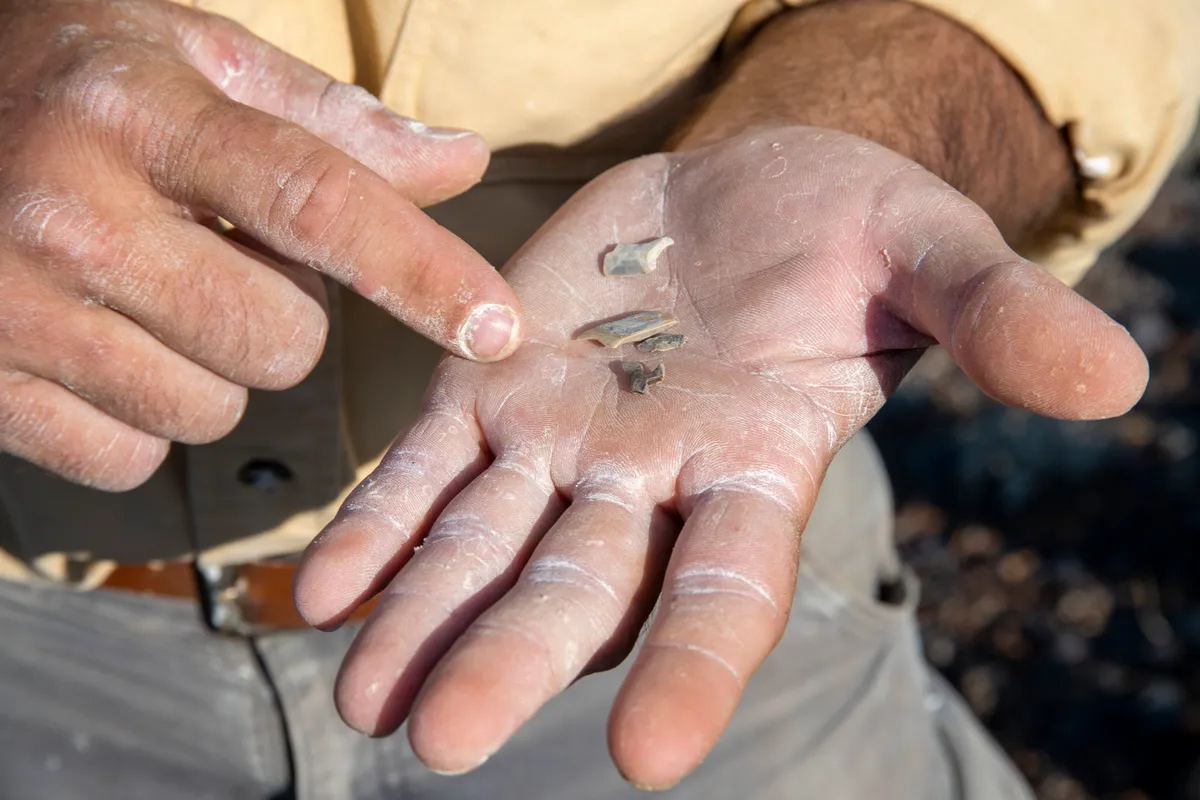
Sir David: When you excavate a site like that you're looking for what was the landscape like and why are these creatures there. There were sandy banks between a river system and forest, and what made him think it was strange was the fact that he found ammonites, which are sea marine creatures. This site is a freshwater site, so why were they there? That was one of the clues that put Robert DePalma on the trail thinking maybe this is something to do with the asteroid strike.
How did Robert DePalma link the site to the Chicxulub asteroid of 66 million years ago?
Sir David: The interesting thing about Tanis is that it's around 2000 miles away from where the meteorite hit, in the sea off Mexico. So how do you know that it was the Chicxulub asteroid that was responsible for killing the creatures in Hell Creek? And the answer is that when a huge meteorite hits and pulverizes the earth the explosion produces an enormous amount of molten rock and some of this turns into tiny glass beads called ejecta spherules.Tthese tiny little fragments are then distributed over a wide area by natural forces.
Helen: Scientists calculated that ejecta spherules from an asteroid that hit off Mexico would have taken between 13 minutes and a couple of hours to fall at Tanis.
Sir David: Robert found spherules in the gills of the fish he was excavating at Tanis. The fish “breathe” by taking in oxygenated water and putting it through their gills and expelling it –and so anything that they take in has just arrived. And they found these spherules in the gills of these fish.
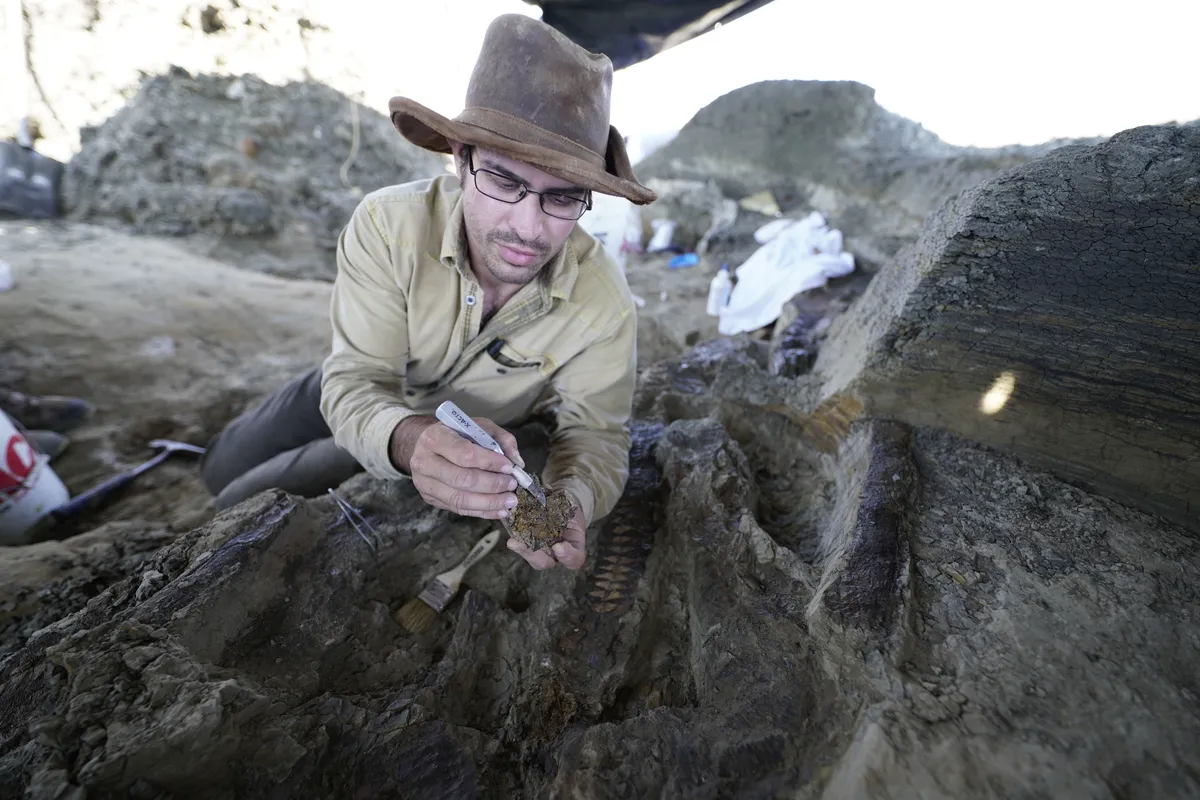
The spherules found at Tanis were first analysed in America. In this country the synchrotron in Oxfordshire is also one of the few places in the world where you can do a detailed analysis of the chemical makeup of spherules. Samples from Chicxulub are identical chemically to spherules that have been discovered in Hell Creek. So you have got the link.
What’s the significance of the discoveries, what does it tell us that we didn't know before?
Sir David: I mean we know the dinosaurs disappeared in one particular time. It makes that particular event, very very vivid indeed. Because when you see the spherules in the gills of the fish it is extraordinary to understand the nature of that evidence, it is extraordinary to hold that in your hand and say, this spherule fell within hours of the asteroid impact. This is evidence of the event that caused 75% of species on earth to disappear. And you have a heart of flint not have it beat just a little faster when you're faced with that sort of thing.
So what other discoveries did DePalma make when he started excavating the site?
Sir David: Well, Robert of course has a team working with him, who've been totally involved. I know what distinguishes this programme, as far I'm concerned, is that you get the moments of discovery, of real discovery. And, you can see that for yourself when you hear these scientists working, arguing among themselves as to how they should deal with a find, how they prevent destroying it when they are excavating it and what technique they’ll be using to get the fossils out. I found that very, very interesting and a convincing demonstration of what it's like to be on one of these important excavations.
Robert found a T.rex tooth which I held in my hand. When you think about a Tyrannosaurus rex, you think part of an enormous great impressive beast, but I’m just holding a little tooth. But none the less it was very important.
Helen: One of our production team, Tom Scott, was there in 2019 when they discovered a turtle. But they can only dig in the summer when the weather's good enough so, although they found the beginnings of a turtle then, they couldn't take the whole thing out before the weather turned. So the next summer the rest of the turtle was taken out. But to get it out in one piece they had to freeze it using liquid nitrogen. And this technique has been used on human remains but I don't think it’s often been used on paleontological remains.
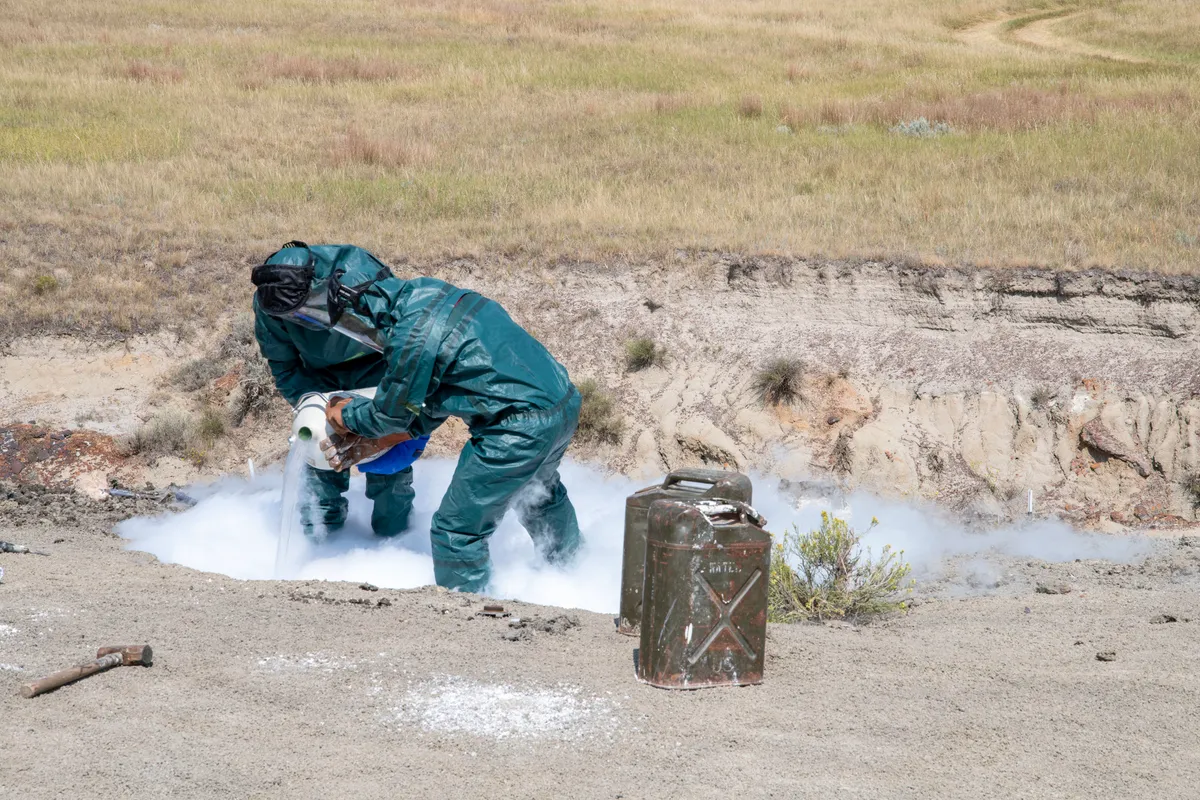
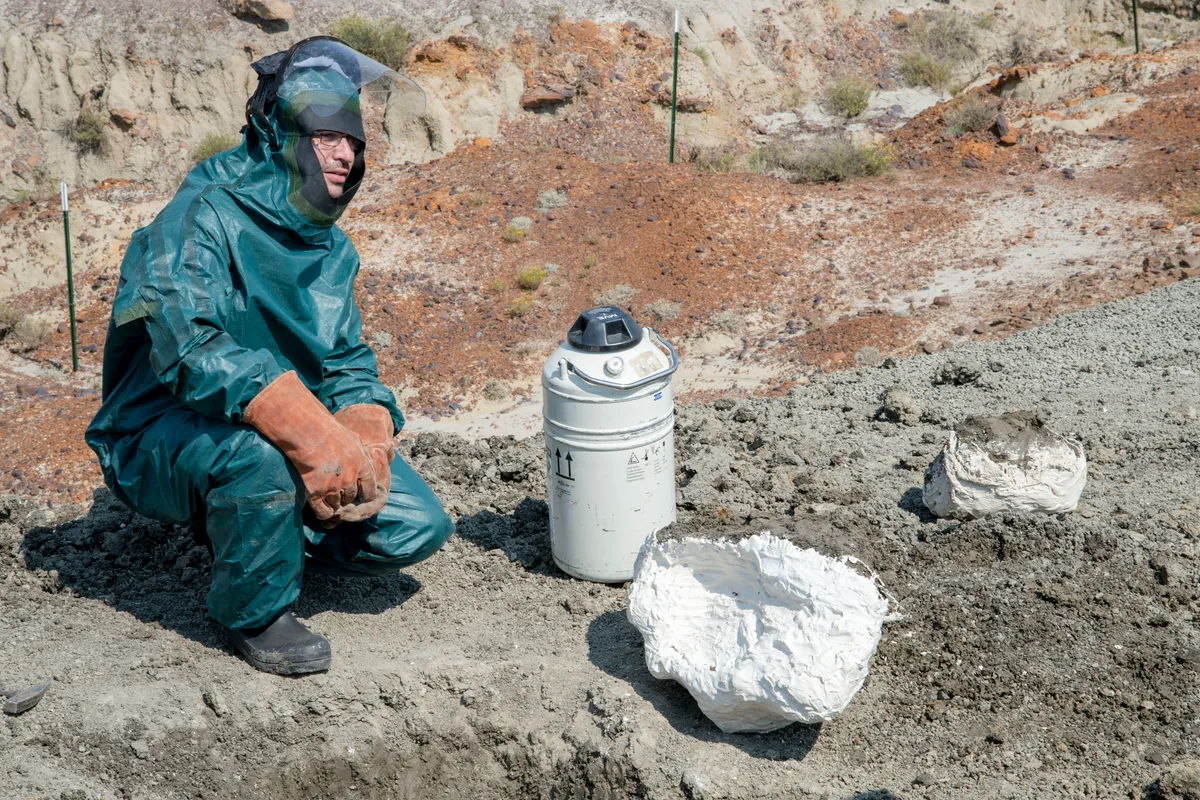
David, you managed to see quite a lot of Robert DePalma’s new fossils. Can you tell us a bit more about them?
Sir David: Part of the scientific process in these matters is that if you have a discovery you show it to your other workers from within the field to discuss it. In order to verify and confirm some of the claims that were being made, Robert found it necessary to bring some of the key specimens over to this country to show to British experts - Professor Phil Manning who’s an acknowledged expert in dinosaur history.
So fortunately for us, the key specimens were brought over here and we were able to film them together with Robert, Phil Manning and Professor Paul Barrett as well from the Natural History Museum, London. And so, both these experts were there to verify the findings and deductions being made by Robert.
The fossilised creatures in Tanis, alongside the spherules, all seem to have been buried instantly in a muddy surge of water. What can you tell us about this surge and what caused it?
Sir David: It was a bit of a puzzle. Obviously, if you get this huge rock hitting the sea - because the asteroid strike was in the sea - it could cause an immense tsunami. But then there were some characteristics which didn’t add up, because it would take a long time for a tsunami to travel 2000 miles from the impact site, all the way to Tanis.
And the solution, which is actually revealed in the film, is that the important wave of water caused by the impact, was not caused by a tsunami, but by vibrations which actually travelled through the Earth itself and arrived at the river system at Tanis much more quickly, creating a surge of water
Helen: It’s thought the surge of water was caused by seismic waves. At that stage the middle of America was bisected by the Western Interior Seaway and so the seismic waves could have passed through North America and created a sort of turbulence around the river system at Tanis which happened within a couple of hours of the impact and created a big, muddy surge while the spherules rained down.
So everything buried in that big surge wave could have been deposited within a couple of hours of the impact. It was 66 million years ago, and yet we can have a pretty good idea of what might have happened on one individual day.
Sir David: It is totally phenomenal and unique. No other event was synchronized to have an effect on this planet simultaneously, globally, no other event.
The wave is a big part of why Robert and his team’s fossils are so well preserved. Is the preservation something that's unique about Tanis.
Helen: I think it's because the surge dumped all the mud and debris so quickly, and everything was preserved in an instant, with skin and tissue. It's about the speed of entombment as it were - a bit like the bodies that were so well preserved in Pompeii.
Sir David: We know quite a lot about skin and tissue of dinosaurs from other deposits. There are some very impressive dinosaur fossils which were found in sand dunes where in fact an animal died and was covered in sand. Some of the first specimens of skin from dinosaurs were found in sandy deposits. And we’re discovering more and more about the soft tissues of dinosaurs.
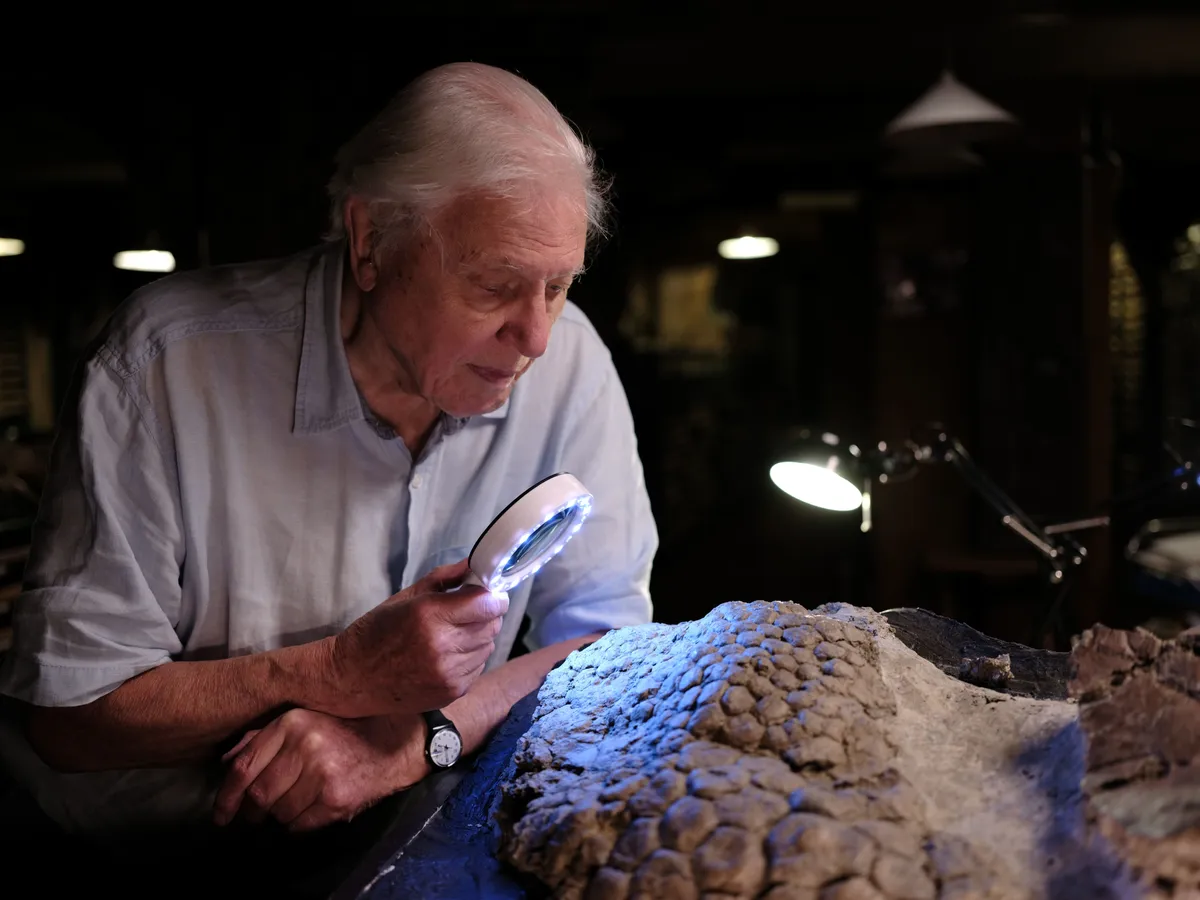
How did the programme go about accurately depicting the appearance and behaviour of the dinosaurs?
Helen: We’ve obviously used a lot of CGI [computer generated imagery], and visual effects to bring the creatures to life. We wanted to make them as accurate as we possibly could, and so we consulted a lot of scientists – from paleontologists to locomotion scientists to paleo-artists at each stage as we were creating the CGI.
We based the creatures’ behaviour on fossil evidence as far as we could. Two independent scientific experts then watched the final film to make sure that we were as accurate as we could be.
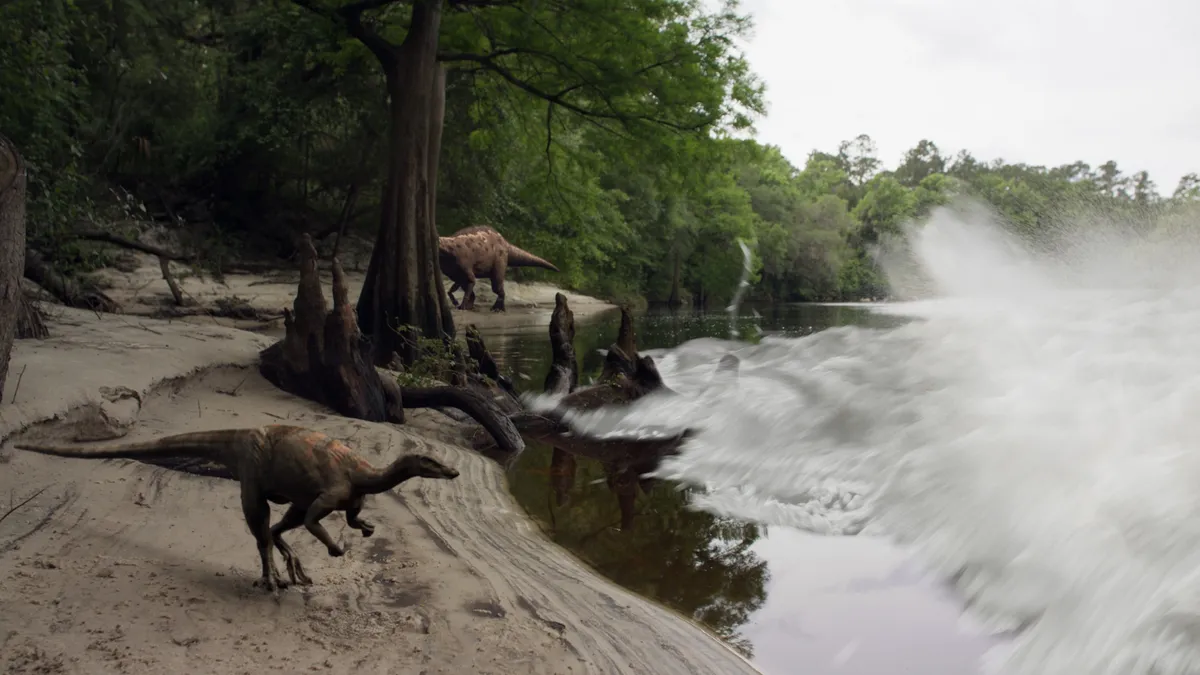
Let’s talk about some of the technology involved in the film. Some new technology was necessary for David to appear in the late Cretaceous alongside the creatures that live 66 million years ago. How was it for you filming in a virtual studio - was it challenging, was it fun?
Sir David: I've done quite a bit in studios one way or another over the past few years, so I'm accustomed to doing that sort of thing. But we’ve gone far beyond the old days of the cinema, when you had green screens and after filming you were able to replace the screen electronically to make you appear in any landscape you wished. When I walked into that studio the images were all already there, the back end of the studio was a forest on fire, and it was very, very impressive too. It's quite unsettling suddenly to go in and see fire leaking through the frames of a forest that aren’t in the studio, but that's what it looks like.
Helen: It’s a very new technique this virtual studio, pioneered on the DisneyPlus TV series The Mandalorian. And the differences between a green screen and this is that here you've basically got a single camera which has a tracking device in it, so when you move or the camera moves, the background moves as well. But obviously we had to create a big set in front of that.
So we had David, who is so patient, waiting while we were moving trees and plants in and around him, and then we had haze machines – but then there was too much smoke or too little - and we had a wind machine but it was too windy or not windy enough! So we were experimenting as it’s very much cutting edge technology, and I know David you love new technology, don't you, so you were joyously fascinated by this, which was brilliant.
Sir David: I can’t see how it can be made more visually impressive. I mean it seems all the problems have been cracked and it really is extremely convincing.
Helen: It was great fun. It's really good to be involved in cutting edge technology and I think the potential for it is huge, but we were all experimenting and learning together.
People on the whole, including yourself, seem endlessly fascinated with dinosaurs. Why do you think that is?
Sir David: People are fascinated by dinosaurs. And children are fascinated by their names with which they wish to bamboozle their grandparents, do you know grandpa, do you know what this is and the others. I yearn to find a bit of dinosaur myself but they are fairly rare in this country, although of course it was in Britain that they were first discovered.
Well, there were a number that were first found here. They tried to model some of them in Crystal Palace and the early models are still there. The Iguanodon was one of them. In the early 19th century some teeth were found by a doctor who lived on the south coast in Sussex. And it was thought they were very likely the tooth of a lizard that looked like an iguana - and so it was called iguanodon, but it’s many times bigger than any living iguana. And that was one of the first dinosaurs that was identified. And it was Sir Richard Owen, of course, of the Natural History Mueum who coined the term Dinosauria, he said they were “terrible lizards”. So this country was the first country to recognise dinosaurs.
David, could you tell us what discovery or which aspects of the filming you found particularly fascinating?
Sir David: Well, there is one moment when there is one of those electric moments of proof. We didn't know what the answer was going to be. We had a Professor alongside us and he took a spherule and got the chemical profile of it. And he found that it was exactly the same - from Chicxulub and from Tanis. It was a moment of justification for the whole thing really.
Helen: One of my favourite moments of the filming actually was when we were setting up in what we called the fossil workshop, where we filmed the fossils we brought over from America. And we had a pause in filming to reset and I turned around, and there was David with a brush and a scalpel, and you were examining one of the fish fossils yourself, and it was brilliant, it was as though the filming just didn't exist and you were investigating the fossil with Robert DePalma and Phil Manning, And it was just such a lovely moment, that you were so invested in the discovery, it was brilliant.
Sir David: It is very romantic. It is escapism in some ways but it’s very romantic.
There have been a lot of dinosaur films made over the years. What's different about this one, and why have you made it now?
Sir David: We couldn’t have made it any other time. My breath was taken away when I first heard about the project. To anybody with any imagination at all, the notion that you could actually see fish that died at the same time as the asteroid strike which killed the dinosaurs is very, very romantic.
The film is so vivid I worry that people may think this is going to happen to us any moment now. But actually if there was a meteorite like this heading our way, there are plans being made on the way in which we would be able to divert it. There are strategies and plans being made to deal with that.
Helen: You're absolutely right. NASA has a current mission called DART. It’s a mission aimed at testing a way of protecting us against near-Earth objects. They're aiming to deflect an asteroid called Didymos B. It's only a tiny asteroid, a moonlet, about 160 meters in diameter, which is much much smaller than the one that hit Earth 66 million years ago. But they're going to try and crash into Didymos B later this year and change its orbit very slightly.
Sir David: But this film is so convincing that you have no doubt about the scale of the catastrophe that was created 66 million years ago. This planet was devastated and the survival of anything at all, and the fact that we are here, is partly due to the fact that the small mammals that lived in burrows in the ground, weren't affected nearly so badly. They were able to survive until life managed to recover and in such time plants began to grow again and roots began to grow again and animals could feed again. But it was a major catastrophe of global extinction of 75% of all species on Earth.
Helen: I think sometimes we don't realize that mammals and dinosaurs coexisted. That perhaps there were dinosaurs and then there were mammals, but actually they coexisted
Sir David: Yes, but the early mammals were small nocturnal creatures, furry and many of them lived underground. The other reason that animals of various kinds survived this impact is if they lived in water. Crocodiles existed throughout the period of the dinosaurs, and the reason they weren't exterminated is because they lived in water - and the ecosystems in freshwater recovered probably earlier than many on the land.
It's a tragic story. Were you worried at all that it was going to be a sad depressing story to bring to life?
Sir David: Yes, on the other hand, if it hadn't happened we wouldn't be here.
Do you think that there's anything to be learned from this extinction?
Sir David: The production has portrayed the day of the extinction so vividly, it is very powerful and I think people of a nervous disposition do need to have some reassurance that we are not just sitting here waiting for it to happen again, that we know what we're going to do about it.
Helen: Yes, I think it's good to learn from extinctions of the past and apply that learning to the future. Because in the future some of them could be of our own making.
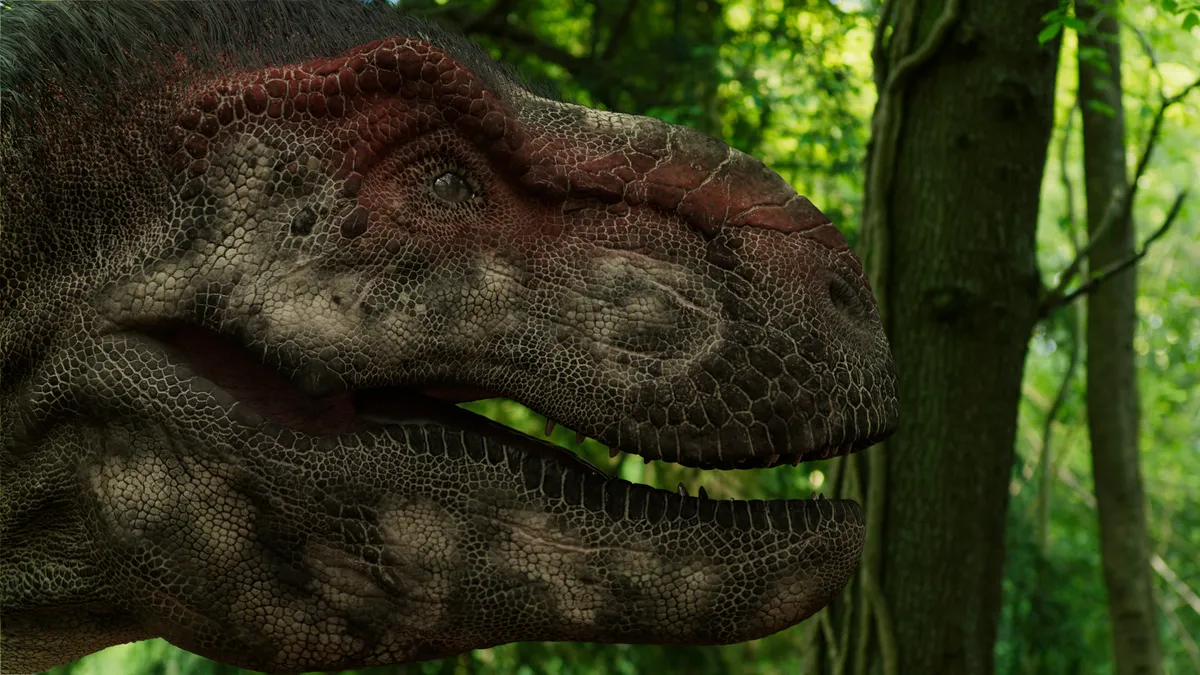
Any last thoughts on extinction in general, learning from the past and applying that to the future?
Sir David: I don't know, we don't seem to be very good at learning these lessons even if we explain what they are. I mean, it couldn't be more clear what’s happening to the planet at the moment. We aren't doing much about it. This is when you thought COP 26 was at least starting to get nations together and we might actually solve something of one of the most urgent problems the planet faces today.
What do you hope that people take away from watching this film?
Sir David: I think one thing to take away is how using the right scientific techniques, but also thinking and logic, looking at evidence, quite simple evidence like bits of rocks, you can reconstruct what happened in the past and the importance of it all.
Helen: Yes, and I think that by scientists working hard together, bringing together knowledge, and not being divisive, we can learn faster and that's what we need to do at the moment.
During the Covid pandemic, everybody worked together and we got the vaccine so quickly, so I like to think that when scientists work together, we can move mountains.
Sir David: Scientists are pretty good at doing this, politicians don’t work in the same kind of way.
Main image: Sir David Attenborough is the presenter of Dinosaurs: The Final Day, with David Attenborough. © BBC/Ali Pares/Sam Barker/Chris Lavington-Woods/Lola Post Production
